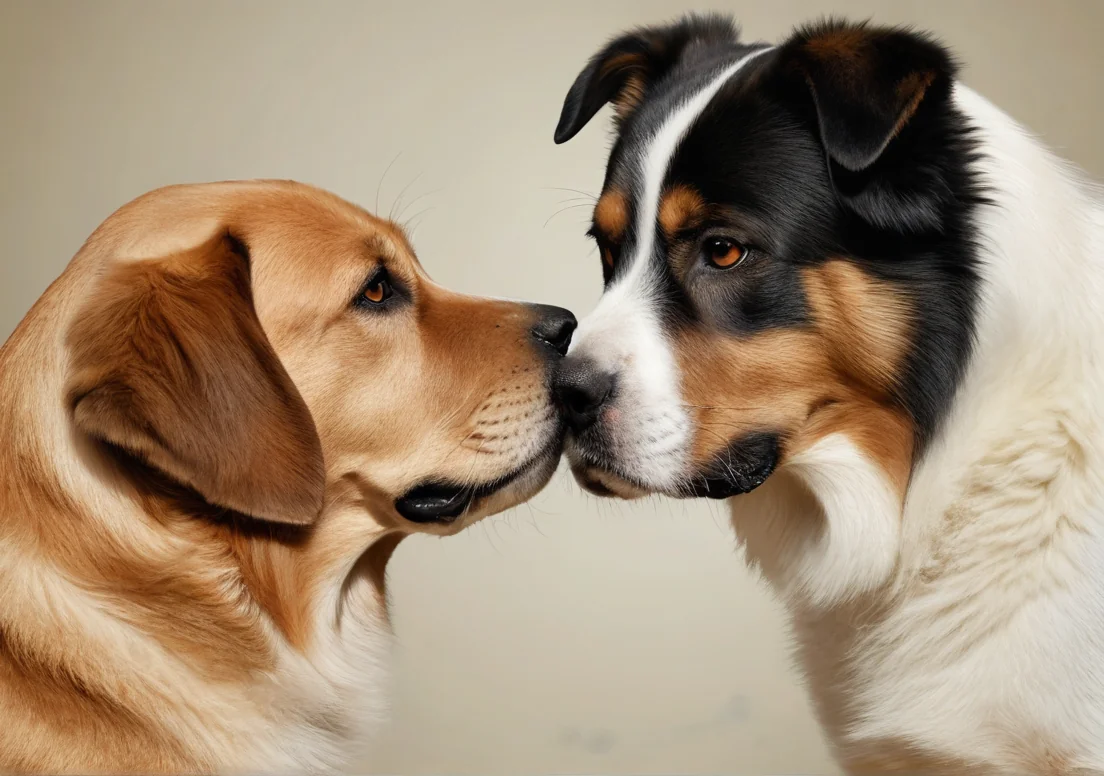Genetics and environment play pivotal roles in shaping dog behavior, particularly aggression. This complex interplay offers fascinating insights into why some dogs may exhibit aggressive tendencies while others have a calm demeanor.
Both genetics and environment contribute significantly to dog aggression, with inherited traits interacting closely with life experiences and training. There’s a deeper narrative woven into this topic that offers surprising perspectives on what influences aggression in dogs, and it’s worth exploring further down the page.

What Genes Influence Aggression in Dogs
Research shows that certain genetic factors are linked with aggressive behaviors in dogs. It’s fascinating how specific breeds reveal predispositions toward aggression, often supported by their historical roles. Breeds like Pit Bulls, Rottweilers, and Doberman Pinschers have been noted for increased aggression levels; however, it’s crucial to stress that these traits don’t define all individuals of these breeds.
Genetic predispositions come from a mix of multiple genes, impacting traits like temperament, sociability, and reactivity. Behavioral genetics studies have identified candidate genes, such as those related to serotonin regulation, which can influence mood and aggression levels. For example, variations in the serotonin transporter gene (SLC6A4) have been associated with impulsive behaviors that may lead to aggression.
Another interesting angle is the role of heritability. Some breeds show a stronger heritability for aggression, meaning if the parents display aggressive behavior, their offspring might be more likely to as well. To get a broader picture, scientists are also looking at the environmental interactions of these genetic markers, emphasizing that aggression is rarely purely genetic—it’s a mix of nature and nurture.
Understanding these genetic components helps us better manage and train dogs, acknowledging that while some may have higher risk, environment and training can significantly shape behavior throughout their lives.
How Does Early Socialization Impact Aggression
Socialization is a crucial factor in shaping a dog’s personality and behavior. The early critical socialization period, between 3 to 14 weeks, is the prime time for puppies to learn about the world around them. During this stage, a puppy’s experiences can either bolster their sociability or introduce fears that might lead to aggression later on.
For instance, exposing a puppy to a variety of situations, people, and other animals helps them develop confidence and good social skills. If a puppy isn’t properly socialized, they might grow up feeling threatened by unfamiliar experiences, which can manifest as fear-based aggression.
Key aspects of early socialization include:
- Exposure to different environments (e.g., parks, urban settings)
- Interactions with a range of people (men, women, children)
- Interaction with other animals, including dogs of various sizes and temperaments
Studies indicate that dogs that had a positive and diverse early life tend to display fewer aggressive tendencies as adults. A fascinating finding suggests that not only the exposure matters, but also the quality of these experiences. Puppies exposed to stressful or negative situations during socialization may become more reactive compared to those who encountered positive, well-managed interactions.
An additional tip: engaging in puppy training classes can provide structured environments for socialization, helping puppies learn how to interact appropriately while channeling their energy positively.
What Environmental Factors Contribute to Aggression
A dog’s environment plays a significant role in its behavioral development, including aggression. Several external factors can provoke aggressive behavior, often spiraling out of control if not addressed early. Key elements include:
Living Conditions : Dogs raised in crowded, chaotic households or environments without a stable routine may experience stress, leading to anxiety and aggression. A well-structured, calm environment can greatly reduce these risks.
Socialization : Early exposure to various people, animals, and situations helps a dog learn to navigate the world without fear. Dogs that aren’t properly socialized may react aggressively out of fear or uncertainty when faced with new stimuli.
Training Style : The approach used during training can either exacerbate aggressive tendencies or help mitigate them. Positive reinforcement promotes trust and secure attachments, while harsh methods can lead to fear-based aggression.
Physical Environment : Access to adequate space and safe play areas encourages healthy behavior. Dogs confined in small spaces or insufficiency of mental stimulation may resort to aggression out of frustration or boredom.
Owner Behavior : Dogs are intuitive and often mirror their owners’ emotions. An anxious or aggressive owner can inadvertently teach their dog to display similar behaviors.
These factors intertwine, showing that while genetics lay the groundwork, the environment plays a pivotal role in shaping a dog’s aggressive behavior. Creating a nurturing environment is essential for preventing aggression.
Can Training Mitigate Aggressive Behaviors
Training is a powerful tool in reducing aggressive tendencies in dogs. Consistent, positive strategies can foster better behavior and deeper connections. Some effective methods include:
Positive Reinforcement : Rewarding good behavior with treats or praise encourages dogs to repeat those actions. This builds their confidence and helps them understand what’s expected.
Desensitization : Gradually exposing your dog to their triggers in a controlled manner can help them become accustomed to the situations that usually provoke aggression, teaching them to remain calm.
Counter-Conditioning : This involves changing a dog’s emotional response to a trigger. For example, if your dog becomes aggressive towards other dogs, rewarding calm behavior when near them helps shift their perspective.
Clicker Training : Using a clicker at the moment a desired behavior occurs provides instant feedback, making learning clearer for your dog.
Professional Guidance : Engaging a certified dog trainer or behaviorist can offer tailored strategies. They can assess your dog’s specific needs and suggest appropriate interventions that fit your dog’s temperament.
Also, consider the importance of routine and consistency in your training. Regular practice and clear boundaries make it easier for dogs to understand their roles. Ultimately, with commitment and the right techniques, you can help your furry friend replace aggressive tendencies with positive behaviors, leading to a happier and more harmonious life together.
Is Breed Type a Significant Factor
Certain dog breeds are often associated with specific traits, including aggression, based on their genetic background. Breeds like Pit Bulls, Rottweilers, and Doberman Pinschers frequently get a bad rap, but it’s crucial to understand that genetics is just one part of the equation. Some breeds might have higher tendencies toward protective or assertive behaviors, but that doesn’t mean every dog of that breed is prone to aggression.
Here’s the kicker: most of the aggressive behaviors you see stem from a combination of genetics, socialization, and environment. While breed type can predispose a dog to certain traits, the way they are raised, trained, and socialized plays a massive role in shaping their behavior. For example, a well-socialized Pit Bull can be just as gentle and friendly as a Golden Retriever. Focusing on responsible ownership and proper training can significantly mitigate any genetic predispositions.
Specific factors influencing aggression in breeds include:
- Genetic traits for guarding or herding behaviors.
- Lack of socialization during key developmental periods.
- Health issues, such as pain or discomfort.
- Training—positive reinforcement vs. harsh methods can dictate behavior outcomes.
Understanding these nuances helps paint a fuller picture of how breed attributes might play a role in aggression while emphasizing the importance of proper care and socialization.
How Do Stress and Anxiety Affect Dog Aggression
Stress and anxiety can turn even the most docile dogs into aggressors. High-stress situations—like loud noises, unfamiliar environments, or changes in routine—can trigger a fight-or-flight response, leading a dog to act out aggressively. Recognizing the signs of stress is vital for any dog owner.
Some common stress indicators include:
- Panting or excessive drooling.
- Whining or barking excessively.
- Tail tucking or body stiffness.
When dogs experience anxiety, they may feel threatened, leading to defensive aggression. For instance, if a dog feels cornered or overwhelmed, they might lash out, perceiving a person or another dog as a threat.
Addressing these issues starts with creating a safe environment. Here are some practices that can help manage your dog’s stress and reduce aggression:
- Introduce calming routines: Safe spaces, like a quiet room or crate, provide a retreat for your dog during stressful moments.
- Regular exercise: Physical activity helps release pent-up energy, which can prevent aggression stemming from frustration or anxiety.
- Desensitization training: Gradually exposing your dog to stressors in a controlled manner can help them build resilience.
It’s vital to pay attention to your dog’s emotional needs. Simple steps like establishing a routine or offering mental stimulation can go a long way in fostering a calm and secure environment—ultimately curbing any aggression tied to stress or anxiety.
What Role Do Hormones Play in Dog Behavior
Hormones can have a significant impact on dog behavior , particularly aggression. The main players in this hormonal symphony are testosterone, cortisol, and oxytocin.
Testosterone is often linked to aggressive behavior. Higher levels can lead to increased dominance and territoriality, especially in intact male dogs. It’s crucial to note that not all testosterone has the same effect; genetics and environment can modulate how a dog expresses aggression.
Cortisol, on the other hand, is related to stress. Elevated cortisol levels, often resulting from chronic stress or trauma, can trigger anxiety and aggressive reactions as dogs feel threatened. Recognizing stressors in a dog’s environment—like loud noises or hostile encounters—is vital in managing their hormonal responses.
Meanwhile, oxytocin is the so-called “love hormone.” It’s released during positive interactions, like playtime or petting. In dogs, higher oxytocin levels promote social bonding and reduce fear, which can lead to reduced aggression. Understanding this interplay of hormones can help owners foster more positive environments that encourage calm behaviors.
Just remember, balancing hormones through proper care, training, and environment can greatly influence a dog’s temperament.
What Are the Signs of a Potentially Aggressive Dog
Identifying signs of potential aggression is essential for preventing unwanted encounters and ensuring a harmonious environment. Here are the key behaviors and signals to watch for:
Stiff Body Language: A tense posture or a tail held high can indicate a dog is feeling uneasy.
Growling or Snapping: These vocalizations are clear warnings that a dog may be feeling threatened or defensive.
Bared Teeth: This is a direct threat that signals the dog is ready to escalate if necessary.
Excessive Barking: When barking is driven by agitation or fear, it might indicate an underlying issue with aggression.
Ears Back or Flicking: Ears pulled back can signify fear, while constant flicking may indicate heightened alertness.
Avoidance or Freezing: A dog that suddenly stops moving or tries to back away may be preparing to react aggressively due to fear.
Being aware of these signs is crucial; they can indicate a dog’s readiness to act aggressively under pressure.
Extra Tip: Proper Socialization is key. Exposing dogs to various environments, people, and other animals during their formative months can significantly reduce the odds of aggressive behavior later on. Starting early helps instill confidence and reduces fear-based reactions.
Interesting Facts About Dog Behavior
Dog aggression isn’t just about temperament; it’s shaped by a mix of genetics and environment. Surprisingly, research shows that certain breeds are predisposed to aggressive behaviors, but it isn’t the whole story. For instance, Chihuahuas might be known for their big attitudes, while Pitbulls often carry a high level of stigma despite being trained and socialized well.
In terms of social behavior, dogs communicate with a complex combination of vocalizations, body language, and facial expressions, much like wild canines. For example, a dog’s posture can indicate aggression long before it manifests in behavior. Meanwhile, just as wolves establish their pack hierarchy through aggressive and social behaviors, dogs display similar tendencies in their interactions with other canines.
Curiously, studies suggest that early socialization and experiences can significantly impact a dog’s behavior later in life. Dogs that interact positively with a variety of people, pets, and environments are far less likely to display aggressive tendencies. Understanding these dynamics can help us foster healthier relationships between dogs and their human companions.
- 70% of aggression in dogs can be linked to genetics, but that doesn’t mean it’s hopeless.
- Socialization before six months can drastically reduce future aggression risks.
- Neutering and spaying can sometimes lessen aggressive behavior, especially in sexually motivated aggression.
A solid tip for dog owners: make socialization a priority early on. Diversify their experiences and expose them to different people, animals, and environments to help them develop confidence and reduce aggression.
Unique Perspectives from Experts
Veterinarians, trainers, and behaviorists all agree on one pivotal truth: both genetics and environment play critical roles in dog aggression.
Veterinarian Dr. Lisa Lippman emphasizes that while certain breeds may be genetically predisposed to aggression, a dog’s upbringing can make a world of difference. She advises that lack of proper training and socialization often leads to behavioral issues, challenging the notion that aggression is solely breed-related.
Dog trainer and behaviorist, Karen London, points out that genetic tendencies can be counteracted with training and consistent boundaries. She highlights that a dog’s early experiences can shape its future behavior significantly. A well-socialized dog feels secure and is less likely to overreact to new situations or other animals.
Another expert, behaviorist Dr. John Ciribassi, suggests that the environment interacts with genetics in complex ways. He advocates for positive reinforcement techniques to teach dogs desirable behaviors. He notes that environmental stressors, such as changes in the home or lack of exercise, can elevate aggressive behaviors.
To encapsulate insights from these experts, here are essential takeaways:
- Genetics matter, but environmental influence can shift behavior.
- Early training and socialization are vital to developing a stable dog.
- Ongoing support and positive environments are just as crucial as genetics.
Lastly, investing time in creating a nurturing environment—filled with socialization, regular exercise, and positive experiences—can yield long-lasting benefits in reducing aggressive tendencies in dogs.
Alex, a passionate animal lover, has experience in training and understanding animal behavior. As a proud pet parent to two dogs and three cats, he founded AnimalReport.net to share insights from animal experts and expand his knowledge of the animal kingdom.




